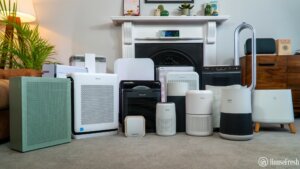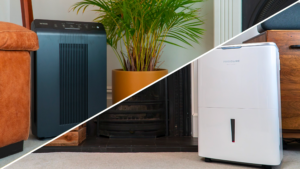Air purifiers are commonplace today. You could spot one in homes, offices, shops, and stores, cleaning the air as people try to rid the air they breathe of airborne impurities and allergens.
Back in the day, we used to answer questions on Yahoo Answers, and very often people would ask why their air purifier is actually making their allergy worse instead of helping. One young woman bought an ionizer air purifier and then told us how it made her allergies worse for the next 6 months. It was only when this purifier broke that her allergies got better.
So, we decided to take a closer look at these issues and answer this question once and for all — will an air purifier make your allergies worse?
What causes allergies in the home?
If we are to understand how to answer this question properly, we first have to learn a bit about the causes of allergies inside our home. Many things can trigger your allergies, some obvious, some not.
Here are some of the most common causes of allergies in the home.
🤧 Pet dander
The tiny bits of skin that come from your pets are called pet dander. They can be found in the air inside your home or on any of the surfaces that your pets come into contact with. Pet dander is microscopic in size, lightweight, and can stick itself to clothing, carpets, and furniture.
According to a study made by the American Lung Association, being allergic to cats is approximately twice as common as being allergic to dogs.
🤧 Mold
Mold is a well-known trigger for allergies and is more common than you may think. If left untreated, it can develop into a serious problem.
Mold can be found anywhere there is moisture, for example:
- Under the kitchen sink caused by a plumbing leak
- Around the corners of your shower because of moisture and steam
- A wet sponge lying on your bathroom vanity unit
🤧 Dust mites
You may not think about it, but dust mites are living in the dust in your home, feeding on skin cells and moisture in the air. The dust mite bodies, droppings and saliva all contribute to the dust in the air and can cause your allergies to worsen.
🤧 Cockroaches
As disgusting as it may sound, cockroaches can also be a trigger for your allergies. It isn’t the cockroach itself that can cause your allergies to flare up, but what they leave behind — droppings, tiny flakes from their bodies and saliva can all be inhaled and make your allergies worse.
🤧 Household chemicals
A household cleaner, hairspray or perfume could also be an allergy trigger. Spraying any of them will leave particles lingering in the air long after you have stopped using them.
🤧 Soft furnishings
Your drapes, bed linen, pillows, and even your carpets can contain allergens, such as pet dander, pollen, or dust mites, and can cause your allergies to flare up.
Allergy checklist
If you suffer from indoor allergies, you may experience symptoms such as:
- Sneezing
- Runny nose
- Sore throat
- Wheezing
- Stuffy, itchy nose
- Coughing
- Tiredness
- Tight chest
- Nasal congestion
The most common of these indoor allergies is nasal congestion, which you can read more about here.
An air purifier will not cure your allergies, but it will reduce the number of airborne allergens present in your home, and can therefore improve your allergy symptoms. The Environmental Protection Agency (EPA) has stated that an indoor air cleaner, particularly a portable one, is one of the best ways to improve air quality in a room or area (their Guide to Air Cleaners for home use can be found here). We identified the best air purifier for allergies based on units that have larger air cleaning power CADR without creating large levels of sound that could disrupt the environment.
So, can air purifiers make allergies worse?
Now that we know a little bit about what causes allergies, and have found out that the Environmental Protection Agency recommends them as a way to clean your air, it’s time to find out why some folk report an increase in their allergy symptoms when using one.
It all boils down to specific type of air purifier you buy.
⚠️Beware of ionizers
Any air purifier that produces ozone during the filtration process, such as an ionic air purifier, is considered harmful to anyone with a breathing illness and can worsen your allergy symptoms.
The reason for this is as follows:
As the air is drawn into the purifier, it is negatively charged by the ionizer and released into the room, where the negatively charged particles are attracted to, and stick to positively charged air particles in the room. The combined particles are heavier than air and drop to the floor ready to be vacuumed up.
During this process, ozone is produced as a byproduct, and ozone can be responsible for making your allergies worse. Not only that, but breathing in ozone can have dangerous side effects such as:
❌Lung damage
❌Shortness of breath
❌Coughing
❌Chest pains
If you have any kind of respiratory illness, you should not use an air purifier that produces any ozone.
No matter how small the quantity, ozone can be extremely damaging to your health. Breathing in ozone over long periods may cause permanent damage to the lungs and even early death for individuals with a compromised immune system.
Choosing an air purifier for allergies
If you or anyone in your family experience any of the symptoms listed above, adding an air purifier may help reduce the symptoms. But to fight allergies effectively, there are a few things to be aware of.
- The air purifier should be perfect for the area you place it in — Be sure to measure the room and look for a purifier rated to handle the square footage. It is generally recommended that you select an air purifier that can cover an area of 100 to 200 square feet more than the room you measured.
- Look for a model that has been certified by the Asthma and Allergy Foundations of America (AAFA) — An AAFA-certified purifier must be able to:
✅Reduce bio-allergens in any confined space
✅Remove the bio-allergens, not redistribute them
✅Not add to the ozone levels in the home
- Find an air purifier with the correct type of HEPA filter — There are three types of HEPA filters:
- Classic HEPA — 99% of particles removed
- True HEPA — 99.97% of particles removed
- Medical-Grade HEPA — 99.995% of particles removed
Each one designed to do a different job by capturing varying amounts of pollutants. This article gives an in-depth look at the different HEPA filter types and may help you decide which filtration system is best.
The air purifier you purchase should also have a “Clean Air Delivery Rate” (CADR) greater than 100. Anything less could worsen your allergies because the purifier may recirculate pollutants and allergens around the room.
If you are looking for an air purifier that won’t make allergies worse but can significantly reduce the number of allergens, be sure to check the list below of our recommendations:






How not to make allergies worse with your air purifier
As mentioned above the most important thing is to avoid ionic air purifiers, but here are two more things we want to make you aware of:
- Run your air purifier continuously
Once the air in the room has been cleaned, do not be tempted to switch the unit off. Switching it off could result in poor air quality returning quickly and make you feel worse. It is better to leave the unit running on a lower speed to maintain the filtration process, or if the unit has an automatic setting, then set the unit to auto and let it do its job.
- Change the filters regularly
If you don’t, the filters can get clogged and the unit’s efficiency will deteriorate. Bacteria that get trapped in the filters can produce toxins and be released back into the room. Mold spores in the filter can stay alive, feeding on dirt and dust particles, only to be sent back into your home by the fan.
Final thoughts
Here at Housefresh we pride ourselves on providing clear answers and the science to back them up. So there you have it, a comprehensive answer to this important question. Knowledge is power, and by reading about allergies and the different types of air purifiers, you can empower yourself to make the right choices.
Last update on 2024-04-22 / Affiliate links / Images from Amazon Product Advertising API







